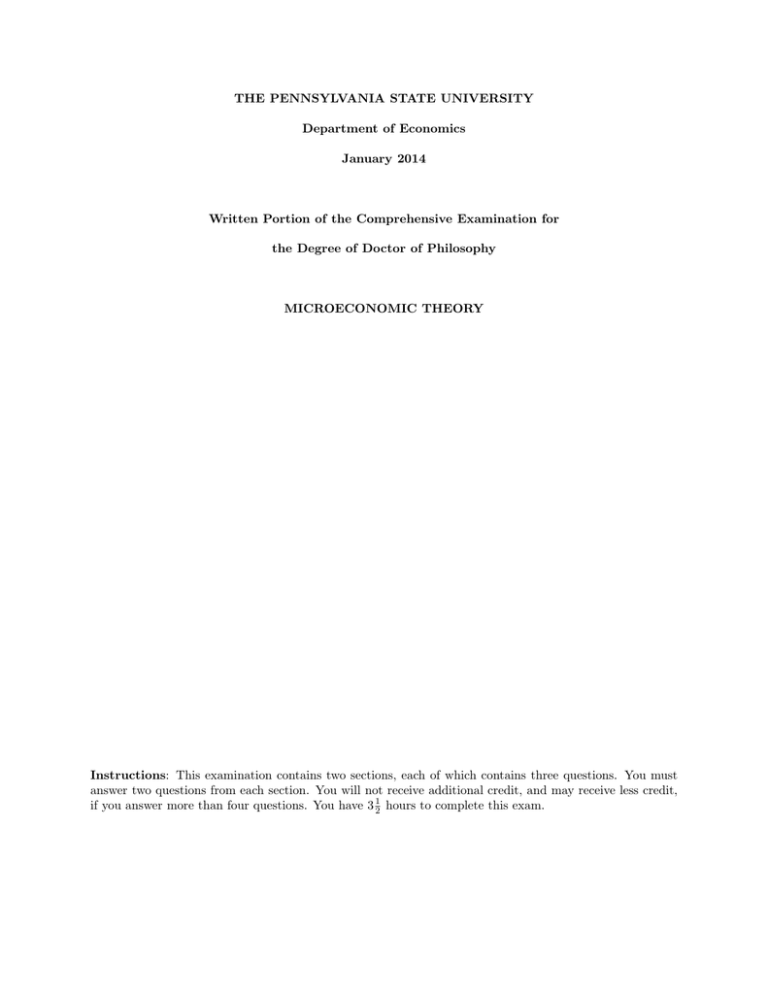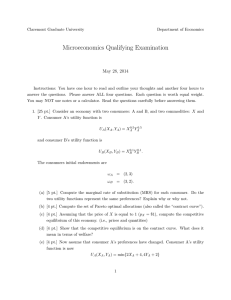THE PENNSYLVANIA STATE UNIVERSITY Department of Economics January 2014
advertisement

THE PENNSYLVANIA STATE UNIVERSITY
Department of Economics
January 2014
Written Portion of the Comprehensive Examination for
the Degree of Doctor of Philosophy
MICROECONOMIC THEORY
Instructions: This examination contains two sections, each of which contains three questions. You must
answer two questions from each section. You will not receive additional credit, and may receive less credit,
if you answer more than four questions. You have 3 21 hours to complete this exam.
Section I
1. Consider a two-agent, two-good exchange economy E = (ui , wi )2i=1
specified by the utility functions
u1 (x1 ) = min {x11 , x12 }
u2 (x2 ) = max {x21 , x22 }
(xik denotes i’s consumption of the good k) and endowments
w1 = (1, 0)
w2 = (0, 1)
(a) Find the set of (weak) Pareto efficient allocations for E.
(b) Argue that E does not have a Walrasian equilibrium.
(c) Let E (2) denote the two-fold replica of the economy E, that is,
E (2) is an economy in which there are two consumers with utility
function u1 and endowment w1 and two consumers with utility
function u2 and endowment w2 . Show that E (2) does have a Walrasian equilibrium.
(d) Let E (n) denote the n-fold replica of E, that is, E (n) is an economy in which there are n consumers with utility function u1 and
endowment w1 and n consumers with utility function u2 and endowment w2 . Under what conditions does E (n) have a Walrasian
equilibrium?
(e) Define an ε-Walrasian equilibrium (p∗ , x∗ ) in the same way as
a Walrasian equilibrium with one amendment: for all i, if xi is
an affordable consumption bundle then ui (xi ) − ui (x∗i ) ≤ ε. Show
that for all ε > 0, the economy E (n) has an ε-Walrasian equilibrium
if n is large enough.
1
Section I (cont.)
I.2 Suppose that a consumer has a regular (complete and transitive) preference relation L
L
and and wealth w > 0 (w is a number). Let pa , pb ∈ IR+
, let xa be a commodity
on IR+
bundle in the consumer’s demand set at (pa , w), and let xb be in the consumer’s demand
set at (pb , w).
a) Decompose the demand change xb − xa into a substitution effect and an income effect.
You may use either the Hicks definition or the Slutsky definition, but be sure to state
which you are using.
b) Using additional assumptions if necessary, prove that the substitution effect has a
nonpositive inner product with the price change pb − pa . State your assumptions
clearly, and be as general as you can.
I
I.3 Consider a production economy with a single firm, E = (i , wi , θi1 )i=1 , Y1 . For
L
, the
each consumer i, i is a regular (complete and transitive) preference relation on IR+
L
endowment bundle wi ∈ IR+ and θi1 is consumer i’s share of the firm. The production set
L
.
of the firm is the nonpositive orthant, Y1 = −IR+
a) Define a competitive quasi-equilibrium for this economy.
b) Let (x∗i )Ii=1 , y1∗ be a Pareto efficient allocation. Using additional assumptions if nec∗
L
essary, prove
that there exists
a nonzero and nonnegative price vector p ∈ IR+ \{0},
such that p∗ , (x∗i )Ii=1 , y1∗ is a competitive quasi-equilibrium. State your assumptions clearly, and be as general as you can.
c) Did you assume (or make other assumptions that imply) that at least one consumer
has nondecreasing preferences? If your answer is “Yes,” give an example with two
2
commodities and one consumer (and Y1 = −IR+
) showing that this property is essential.
d) Did you assume (or make other assumptions that imply) that at least one consumer is
locally non satiated? If your answer is “Yes,” give an example with two commodities
2
and one consumer (and Y1 = −IR+
) showing that this property is essential.
2
Section II
II.1(a)Consider the following game that is played T times. First, players move simultaneously and independently. Then each player is informed about the actions taken by the
other player in the first play and, given this, they play it again and so on. The payoff for
the whole game is the sum of the payoffs a player obtains in the T plays of the game.
A
B
C
a
b
c
3,2 5,0 0,1
2,6 4,4 1,2
1,2 0,3 2,3
(a.i)How many subgames are there in the repeated game?
(a.ii)Find the smallest value of T such that it is possible for B and b to be played in
the first play of the game, in a subgame perfect equilibrium. Describe the strategies that
constitute such an equilibrium. Consider only pure strategies.
(b) Consider a seller S of identical durable goods with three potential buyers, H, M, L
with values for the good vH , vM , vL respectively. Suppose the buyers and seller have a
discount factor δ. (Remember a durable good is a good that gives a utility payoff in each
period once purchased; the value is the discounted sum of such utilities and we are in a
quasi-linear world, so you can assume the vi are in the same units as prices.)
The market opens at two dates, 1 and 2. At date 1, S announces a price p1 , following
which H, M, L simultaneously and independently decide to buy or not. Everyone observes
who remains in the market for date 2. Given this, S announces a price p2 at date 2 and the
buyers remaining then decide whether to buy or not. If buyer i buys in period 1 at a price
of p, his payoff is vi − p. If he buys in period 2, his payoff in the game is δ(vi − p) since
he misses one period’s utility. The seller’s payoff is given by p1 x1 + δp2 x2 , where xt is the
number of items sold at date t.
(b.i) Assume that vH > vM > vL > 0 and 3vL > 2vM > vH . What is the subgame
perfect pricing policy for S? Remember you have to specify a price p2 for every combination
of buyers remaining in the market at date 2. (If you need to you can assume vH > 2vL .)
(b.ii) Now suppose S has only two items to sell. What is the new subgame perfect
pricing policy? Is S better off with two items or three items?
3
Section II (cont.)
II.2 Consider the following game-a coordination game with private information:
A1
B1
A2
1 − c1 , 1 − c2
0,−c2
B2
−c1 , 0
0, 0.
Suppose the costs ci [0, 1 + ε], are independent draws from a uniform distribution on
[0, 1 + ε]. Player i knows ci but not the other player’s cost. The probability distributions
are commonly known.
Find a symmetric Bayes Nash equilibrium (remember a Bayes Nash equilibrium is an
equilibrium in strategies mapping information to actions). Consider equilibria of the following kind: Play B if ci ≥ x, play A otherwise.
II.3(a) Consider two probability distributions F and G on [0,1] with the same expected
value. Suppose the densities of these distributions f (.) and g(.) respectively are related as
follows:
There exist values a, b such that g(x) ≥ f (x) for x≤ a and x ≥ b, with f (x) ≥ g(x) on
[a,b], with each inequality being strict on some positive sub-interval.
Can one identify which of these distributions any risk-averse decision-maker would prefer?
Prove your answer if yes, explain if no.
(b) In the moral hazard problem we went through in class, show that the property MLRP
d fa (y,a)
( f (y,a) ) is increasing in y) implies first-order stochastic dominance, in this
(in this case dy
case, Fa (y, a) ≤ 0 and strictly negative for some range of y. Assume the support of the
density of y is [0, 1].
4







